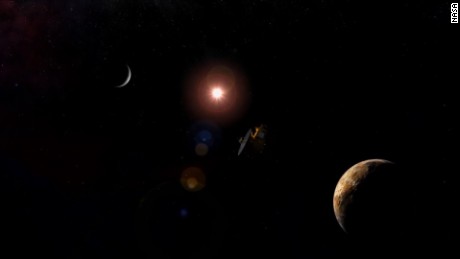New Horizons team proposes new world to explore


(CNN)Remember how big a deal the Pluto flyby was? We may get an encore.
The New Horizons team has recently submitted a proposal to extend its mission, titled Kuiper Belt Extended Mission.
The extension will give the space probe a chance to continue onward to explore the depths of the Kuiper belt, a rocky region that scientists believe is filled with thousands of small, icy objects like comets and asteroids.
This is the same spacecraft that captured the first closeup of Pluto, cruising 7,700 miles over Pluto’s surface, during the space agency’s historic flyby in July 2015.
The initial flyby helped NASA capture images that have provided a wealth of information for scientists, such as discoveries about Pluto’s water ice, floating mountains and potential ice volcanoes. So far about half the data collected during the Pluto flyby has been transmitted back to Earth by the spacecraft, said Michael Buckley, a spokesperson for Johns Hopkins University Applied Physics Laboratory.
The extended mission will give scientists an opportunity to study 2014 MU69, a small world inside the Kuiper belt, which lies about a billion miles away from Pluto. MU69 was identified by the Hubble Space Telescope in 2014 during a search for possible targets the New Horizons team could explore after it flew past Pluto. The target was proposed to NASA in August 2015 as a potential object to explore, but the team had to formally apply for a mission extension this year.
“It’s about 1,000 times more massive than comet 67P that Rosetta is orbiting, but about 500,000 times less massive than Pluto,” New Horizons principal investigator Alan Stern of the Southwest Research Institute in Boulder, Colorado, wrote in a blog post. That means this small world is really small.
Exploring 2014 MU69 will give scientists a better idea of the celestial wonders that lie in our solar system.
“We didn’t know much about our solar system decades ago, and now we’re learning that it is filled with small worlds and other objects,” Buckley said.
The next flyby may also give scientists a more intimate view of MU69 than it got with Pluto.
“The planned flyby will approach MU69 to about 1,900 miles (3,000 kilometers), which is about four times closer than we flew past Pluto,” Stern said.
During the the MU69 flyby, scientists hope to search for the world’s moons, a possible atmosphere and any other data. It’s estimated the New Horizons spacecraft will reach its next destination in three years, a short stint considering it took more than nine years to get to Pluto.
The space probe was designed to go beyond Pluto, and is equipped with enough fuel and outfitted with a communication system so it can stay in touch with scientists on Earth.
“If I do say so myself, the flyby of MU69 would be a landmark event, shattering all distance records for deep-space exploration, and yielding an impressive scientific bounty,” Stern added.
If approved, the proposed extended mission will last until 2021, also giving the New Horizons team a chance to explore elements such as gas and dust floating around the Kuiper belt.
Read more: http://www.cnn.com/2016/04/27/tech/new-horizons-extended-mission-irpt/index.html